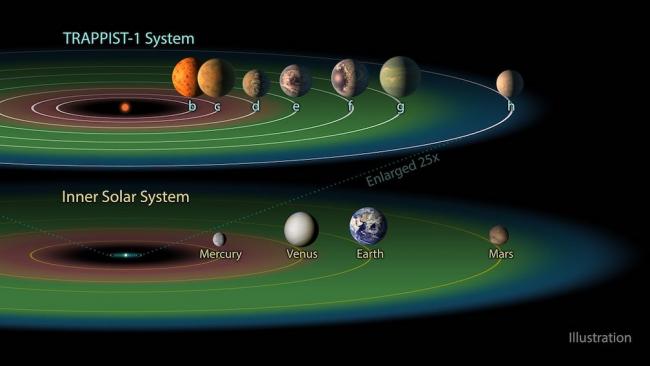
An artist's schematic of the TRAPPIST-1 system of exoplanets with a comparison to the inner solar system planets. Astronomers looking for evidence of a TRAPPIST-1 Kuiper Belt and clues to whether or not its comets might have been available to carry water to the inner set of planets found no evidence for one but were able to set a limit to its size and mass.
TRAPPIST-1 is a system of seven Earth-sized worlds orbiting an ultra-cool dwarf star about forty light-years away. The IRAC camera on Spitzer was used to help discover these seven Earth-sized planets orbiting the star, at least three of them lying in the star's habitable zone. The star, and hence its system of planets, is thought to be about eight billion years old, almost twice as old as our own solar system. For scientists seeking evidence for life elsewhere, the advanced age provides more time for chemistry and evolution to operate than the Earth had. On the other hand, the planets are all close to the star (in fact they are probably tidally locked to the star with one side always facing it), and consequently would have soaked up billions more year's-worth of high energy radiation from the star’s winds, perhaps adversely affecting any atmospheres they host.
Nevertheless, the three planets in the habitable zone could have liquid water if they formed with the right composition and/or if water was subsequently deposited on their surfaces. The Kuiper Belt in our solar system is an orbiting disk of comets and small objects that extends roughly from Neptune out to fifty AU from the Sun (one AU being the average Earth-Sun distance). It is thought that comets brought water to the Earth during its youth, and comets in TRAPPIST-1's Kuiper belt – if there are any – might provide a way to deposit water onto its seven planets. With the right atmospheric conditions, the three planets in the habitable zone might even have liquid water on their surfaces.
CfA astronomer Luca Matra was a member of a team that used the ALMA submillimeter facility to study the TRAPPIST-1 system to look for signs of an exo-Kuiper belt and clues about the formation of its planets. The scientists searched for radiation emitted by dust grains and carbon monoxide gas, but did not find any. The limits were sensitive enough, however, to reach some important conclusions when combined with conservative estimates of the system’s age and evolution. They conclude that probably the TRAPPIST-1 system was born with a planetary disk smaller than forty AU in radius whose mass was less than about twenty Earth-masses, and moreover that very possibly most of the dust grains in the disk were transported inward and used to form the seven planets. The scientists used their modeling code to examine archival ALMA data on the closeby star Proxima Cen and its exoplanetary system. It also showed only upper limits to the dust and gas emission, implying that its young disk was less than about one-tenth as massive as the one that formed our solar system. These results leave the question of early water transport undecided in these systems, but have encouraged the scientists to apply their techniques to younger and closer stellar systems in order to increase their detections and refine their models.
"Searching for a Dusty Cometary Belt around TRAPPIST-1 with ALMA," S. Marino, M. C. Wyatt, G. M. Kennedy, M. Kama, L. Matra, A. H. M. J. Triaud, and Th. Henning, MNRAS 492, 6067, 2020.